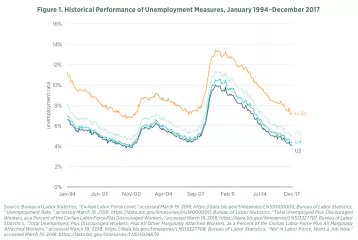- | Government Spending Government Spending
- | Expert Commentary Expert Commentary
- |
Spring is Here, but Not for the Labor Market
The March 2018 Jobs Report is a Lamb not a Lion
The Big Picture
The jobs numbers released by the Bureau of Labor Statistics (BLS) today continued the 9.5 years of previous job growth—a new record—but the pace of growth in March was pedestrian compared to February’s sprint:
- Total nonfarm payrolls increased by 103,000, 42 percent lower than expected
- The unemployment rate held firm at 4.1 percent, as it has since October 2017
- The bright spot is that the comprehensive jobless rate fell slightly to 7.0 percent
The comprehensive jobless rate (CJR) is an all-inclusive measure of unemployment—the highest feasible value that anyone can say unemployment truly is—detailed in my latest research.
The comprehensive jobless rate accounts for those people who fall through the cracks of the official BLS measures of unemployment, like soon-to-be graduates who are actively looking for jobs but are not immediately available to start work. It also counts the very long-term discouraged workers—those who gave up looking for work over a year ago but would still take a job if presented with one.
Because the comprehensive jobless rate is the most inclusive measure of involuntary joblessness, it serves as a benchmark for the other BLS measures of unemployment. In doing so, it helps provide a better overall picture of the labor market.
In addition, the CJR offers a check on political pundits who suggest that the “real” unemployment rate is something much larger, such as President Trump’s repeated assertion that the actual unemployment rate might be as high as 42 percent.
Here’s a great 4 minute video that explains how the CJR accounts for the people who fall through the cracks:
The fact that unemployment has remained constant while the comprehensive jobless rate has slightly decreased suggests that as unemployed workers gain jobs, the potential workers who have been on the sidelines are re-entering the active labor market, replacing the people who were looking for jobs and thereby keeping the unemployment rate at the same level.
Meanwhile, the smaller-than-expected employment growth in March could have been affected by President Trump’s March 1st surprise announcement that he would pursue aggressive tariffs against American trading partners. The anticipation that their material costs may increase could have spooked some employers away from hiring more employees. See my colleague Dan Griswold’s work for more insight on the effect of tariffs on economic growth and how no one wins a trade war. Alternatively, the numbers could be because of the late winter weather that struck the Northeast and Midwest.
Employment
In other news, the initial employment estimates for January and February were revised downward by 50,000, for a total jobs growth of 502,000 over the two months. Combined with March’s numbers, job growth has averaged 202,000 per month in the first quarter of 2018.
Some other good news is that while the average duration of unemployment rose slightly, the number of medium-term and long-term unemployed people dropped:
- The number of long-term unemployed people (27 or more weeks unemployed) dropped by 75,000, more than a five percent decline
- The number of medium-term unemployed people (15-26 weeks unemployed) dropped by 54,000, a decline of almost six percent
- The number of people who weren’t active participants in the labor force, but who still want a job, also slightly declined (by 35,000). This suggests that those unemployed individuals were not exiting the labor force, and were moving off the unemployment rolls because they were finding jobs instead
Wages
Average hourly earnings for all private industry, nonfarm employees rose to $26.82, a 2.7 percent increase over the preceding year. This is on pace with earnings increases over the last few months and was not unexpected.
This aggregate national number disguises the fact that wage growth varies by industry and region. For example, average weekly earnings have risen more rapidly in the goods-producing industries (by 4.6 percent) than in the service-providing industry (by 2.5 percent) over the last year. However, inside the service-providing industry, the retail trade industry’s average weekly earnings rose by 4.4 percent, illustrating that the story on earnings is nuanced, being region- and industry-specific, if not employer-specific.

